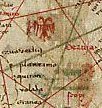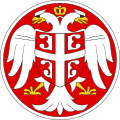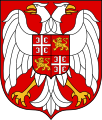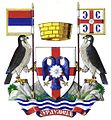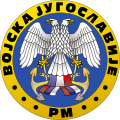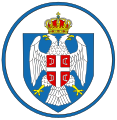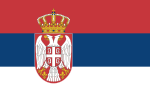Serbian eagle
 Serbian eagle on the shield of the coat of arms of Serbia | |
| Heraldic tradition | Byzantine |
|---|---|
| Jurisdiction | Serbia; Republika Srpska |
| Governing body | Serbian Heraldry Society |
The Serbian eagle (Serbian: Српски орао, romanized: Srpski orao) is a double-headed heraldic eagle, also known as the White eagle (Serbian: Бели орао, romanized: Beli orao), a common symbol in the history of Serbian heraldry and vexillology. The double-headed eagle and the Serbian cross are the main heraldic symbols which represent the national identity of the Serbian people across the centuries, originating from the medieval Nemanjić dynasty.[1] The eagle, defaced with the cross, has been used in the coat of arms of the Kingdom of Serbia from 1882 to 1918 and in contemporary coat of arms of the Republic of Serbia since 2004.
History
[edit]Medieval period
[edit]The double-headed eagle was adopted in medieval Serbia from its use as an imperial symbol in the Byzantine Empire.
The oldest preserved Nemanjić dynasty double-headed eagle in historical sources is depicted on the ktetor portrait of Miroslav of Hum in the Church of St. Peter and Paul in Bijelo Polje, dating to 1190.[1] It had the following characteristics: one neck and two heads, collars on the neck and tail, spread wings, a tail in the shape of fleur-de-lis, heads higher than wings, feet have three toes, the eagle is within a circle.[1] This type of Nemanjić eagle developed between the 12th and 15th centuries.[1] It was very different from the German eagle: two necks, no collars, tail is leaf-shaped, heads are lower than wings, four toes, unspread wings.[1] The Nemanjić double-headed eagle (with the specific characteristics) was depicted on the details of ornaments and textile in the Žiča monastery (1207–20), in the Church of Our Lady of Ljeviš (1307–10), the decoration of Jovan Oliver's clothing (1349), detail on textile from Veluće Monastery (14th century), a detail in the Resava Monastery (1402–27), on the plate of Ivan Crnojević's coat of arms, as well as in other monasteries and churches.[2]
Beginning in the 14th century, the double-headed eagle can be seen more often on inscriptions, medieval frescoes and embroidery on the clothes of Serbian royalty.[3] The Serbian Church adopted it, with the entrance of Žiča Monastery (the seat of the Serbian Archbishopric in the 1219–53 period, and by tradition the coronation church of the Serbian kings) was engraved with the double-headed eagle.[4] The survived golden ring of Queen Teodora (1321–22) has the symbol engraved.[4] During the reign of Emperor Stefan Dušan (r. 1331–55), the double-headed eagle can be seen on everyday objects and state related documents, such as wax stamps and decrees.[4] In 1339, map maker, Angelino Dulcert, marked the Serbian Empire with a flag with a red double-headed eagle.[4]
Other Serbian dynasties also adopted the symbol as a symbolic continuation, like the Mrnjavčević and Lazarević. Prince Lazar (r. 1371–89), when renovating the Hilandar monastery of Mount Athos, engraved the double-headed eagle at the northern wall.[5] The Codex Monacensis Slavicus 4 (fl. 1371–89) has richly attested artwork of the Serbian eagle. The double-headed eagle was officially adopted by Stefan Lazarević after he received the despot title, the second highest Byzantine title, by John VII Palaiologos in 1402 at the court in Constantinople.[6]
The double-headed eagle was used in several coats of arms found in the Illyrian Armorials, compiled in the early modern period. The white double-headed eagle on a red shield was used for the Nemanjić dynasty, and the Despot Stefan Lazarević. A "Nemanjić eagle" was used at the crest of the Hrebeljanović (Lazarević dynasty), while a half-white half-red eagle was used at the crest of the Mrnjavčević.
Modern period
[edit]

After the Ottoman invasion and subsequent occupation that lasted until the early 19th century, the double-headed eagle ceased to be used as it was a symbol of Serbian sovereignty and statehood. The Serbian cross with four firesteels (ocila) came into greater use as another symbol of Serbs. The emblem has mostly been depicted as a white eagle (beli orao, pl. beli orlovi) since 1804, when Gavrilović[who?] issued a revolutionary flag based on the Nemanjić eagle in Stemmatographia.[7]
The Serbian Revolution resurrected the Nemanjić tradition, and the white double-headed eagle became the symbol of Serbia as the coat of arms following independence from the Ottoman Empire. The Serbian cross has been used as the shield with the Serbian eagle in the contemporary design of the coat of arms of Serbia, following the tradition established by the Kingdom of Serbia of 1882.
The coat of arms of 1882 depicts a white double-headed eagle, but not the Nemanjić type, but a German one, despite the fact that it symbolizes heritage of the Nemanjić; the mistake was made by the illustrator of the coat of arms, German Von Schtrel, who "cheated" Stojan Novaković (reputable Serbian historian and minister) and used the German-style eagle instead of the Nemanjić eagle.[8]
It was part of the family coat of arms of both Serbian royal dynasties, the Obrenović and Karađorđević.
The Order of the White Eagle was a royal order awarded Serbian and Yugoslav citizens for achievements in peace or war, or for special merits to the Crown, the state and nation, between 1883 and 1945.
Contemporary period
[edit]Current coat of arms of Serbia is a Serbian eagle on a red shield with a crown above the shield. It is widely used as a base for emblems of other state bodies and services, such as Serbian Armed Forces and Serbian Police, which both use double-headed white eagle i.e. Serbian eagle in their respective emblems. The Order of the White Eagle with swords is the fifth highest order of the Republic of Serbia and is awarded for special merits in the national defense system or special merits in commanding and managing military units, i.e. military institutions and their training for the defense of the Republic of Serbia.
The Serbian national teams in team sports are nicknamed "the Eagles" (Orlovi) in reference to the Serbian eagle, while the Serbian national football team in addition uses a stylized Serbian eagle (charged with Serbian cross) as its emblem.[9][10] There are a dozen football clubs of Serbian diaspora which bear name White Eagles such as Serbian White Eagles FC and Hamilton White Eagles in Canada; and Canberra White Eagles FC, Dianella White Eagles SC, Bonnyrigg White Eagles FC, Albion Park White Eagles FC, Springvale White Eagles FC in Australia.
Gallery
[edit]Historical
[edit]Flags
[edit]-
State flag of the Kingdom of Serbia (1882–1918)
-
Flag of Republic of Serbian Krajina
(1992–1995) -
Flag of Eastern Slavonia, Baranja and Western Syrmia
(1995–1998) -
State flag of the Republic of Serbia (2004–2010)
Coat of arms and seals
[edit]-
Seal of Miroslav of Hum (1198)[11]
-
Fresco detail from Our Lady of Ljeviš
(1306–1307) -
Map detail showing the Serbian flag of arms,
by A. Dulcert (1339) -
Fresco detail of Stefan Lazarević's robe, Manasija (1406–1418)
-
Coat of arms of Stefan Lazarević,
Prussian ed. Chronicle of the Council of Constance (before 1437) -
Coat of arms of Stefan Lazarević,
later ed. Chronicle of the Council of Constance (1483) -
Coat of arms of Stefan Lazarević,
Wernigeroder Schaffhausensches Wappenbuch
(1486–1492) -
Serbian Despotate,
by V. Solis (1555) -
Serbian Despotate,
by C. Silberysen (1576) -
Coat of arms of Stefan Lazarević,
by M. Schrott (1580) -
Coat of arms of House of Nemanjić,
Korenić-Neorić Armorial (1595) -
Serbian Despotate,
German armorial
(c. 1600) -
Coat of arms of House of Nemanjić ,
Belgrade Armorial II (early 17th century) -
Coat of arms of House of Nemanjić,
by S. Rubcich (c. 1700) -
Coat of arms of House of Nemanjić, Stemmatographia (1741)
-
Rassia (Serbia), Stemmatographia (1741)
-
Seal of the Revolutionary Serbia
(1804–1812) -
Coat of arms of House of Obrenović (1882–1903)
-
Coat of arms of House of Karađorđević
(1903–1918) -
Coat of arms of the Kingdom of Serbia
(1882–1918) -
Coat of arms of the Kingdom of Yugoslavia
(1918–1941) -
Seal of the Government of National Salvation (1941–1944)
-
Coat of arms of Republic of Serbian Krajina
(1992–1995) -
Coat of arms of Republika Srpska (1992–2006)
-
Coat of arms of Eastern Slavonia, Baranja and Western Syrmia
(1995–1998) -
Greater coat of arms of the Republic of Serbia (2004–2010)
-
Lesser coat of arms of the Republic of Serbia (2004–2010)
Current
[edit]National
[edit]-
State flag of the Republic of Serbia
-
Greater coat of arms of the Republic of Serbia
-
Lesser coat of arms of the Republic of Serbia
Local
[edit]-
Coat of arms of Belgrade
-
Coat of arms of Niš
-
Coat of arms of Leskovac
-
Coat of arms of Valjevo
-
Coat of arms of Užice
-
Coat of arms of Prijepolje
-
Coat of arms of Mionica
-
Coat of arms of Kuršumlija
-
Coat of arms of Savski Venac (Belgrade)
-
Coat of arms of Stari Grad (Belgrade)
-
Coat of arms of Velika Plana
-
Coat of arms of Čajetina
-
Coat of arms of Surdulica
-
Flag of Despotovac
-
Coat of arms of Derventa (Republika Srpska)
Other usage
[edit]Military
[edit]-
Emblem of the
Serbian Armed Forces -
Emblem of the
Serbian Army -
Emblem of the
Serbian Air Force -
Emblem of the
Serbian General Staff
-
Emblem of the Armed Forces of Serbia and Montenegro (1992-2006)
-
Emblem of the Ground Forces of Serbia and Montenegro (1992-2006)
-
Emblem of the Navy of Serbia and Montenegro (1992–2006)
-
Emblem of the Air Force of Serbia and Montenegro (1992-2006)
-
Emblem of the Army of Republika Srpska
(1992–2006) -
Emblem of the Serbian Army of Krajina
(1992–1995) -
Emblem of the White Eagles paramilitary unit
(1991–1995)
Police
[edit]-
Emblem of the Police of Serbia
-
Emblem of the General Police
-
Emblem of the Criminal Police
-
Emblem of the Border Police
-
Emblem of the Gendarmery units
-
Emblem of the Special Anti-Terrorist Unit
-
Emblem of the Police Intervention Unit
-
Emblem of the Unit for the Protection of the Important Persons and Residences
Orders and decorations
[edit]-
Order of the White Eagle (1883–1945)
Miscellaneous
[edit]See also
[edit]References
[edit]- ^ a b c d e Атлагић 2009, p. 180.
- ^ Атлагић 2009, pp. 181–182.
- ^ Solovjev 1958, p. 130.
- ^ a b c d Solovjev 1958, pp. 134–135.
- ^ Ivić 1910, p. 30.
- ^ Jahrbücher für Geschichte Osteuropas, vol. 8, Osteuropa-Institut München, F. Steiner Verlag, 1960, p. 511.
- ^ Ethnic Groups. Vol. 10. New York: Gordon and Breach. 1993.
- ^ Атлагић 2009, p. 183.
- ^ "ISPLIVAO NOVI GRB REPREZENTACIJE SRBIJE: Ovo je SIMBOL koji će fudbaleri nositi na dresovima? (FOTO)". 26 March 2022.
- ^ "Nadimci Učesnika SP: Četiri puta Orlovi, Tri puta Lavovi, Dva Ne Znate, a kod Dva sigurno Grešite! (Foto)". www.srbijadanas.com (in Serbian). 16 November 2017. Archived from the original on 21 October 2021. Retrieved 21 October 2021.
- ^ Atlagić (2009), citing M. Atlagić (2006), Културни споменици у Србији и суседним земљама и двоглави орао као национални српски хералдички симбол, in: Духовност писане културе Срба у контексту културе балканских Славена, Pristina-Leposavic: Institute for Serbian Culture, 223–259.
Sources
[edit]- Атлагић, Марко П. (2009). Одређивање националних хералдичких симбола на примјеру Срба и Х (PDF). Зборник радова Филозофског факултета. 39: 179–188.
- Ivić, Aleksa (1910). Stari srpski pečati i grbovi: prilog srpskoj sfragistici i heraldici. Natošević.
- Ivić, Aleksa; Mrđenović, Dušan; Spasić, Dušan; Palavestra, Aleksandar (1987). Rodoslovne tablice i grbovi srpskih dinastija i vlastele. Belgrade: Nova knjiga. ISBN 978-86-7335-050-9.
- Novaković, Stojan (1884). "Хералдички обичаји у Срба: у примени и књижевности". Београд: Краљевско-српска државна штампарија. Archived from the original on 2015-04-22.
- Solovjev, Aleksandar Vasiljevič (1958). Istorija srpskog grba. Srpska misao.





![Seal of Miroslav of Hum (1198)[11]](http://upload.wikimedia.org/wikipedia/commons/thumb/4/40/Knez_Miroslav_grb_orla_sa_odezde.png/120px-Knez_Miroslav_grb_orla_sa_odezde.png)
![Stefan the First-Crowned's eagle at Mileševa (1230s)[citation needed]](http://upload.wikimedia.org/wikipedia/commons/thumb/9/9a/Kralj_Stefan_Prvovjencani_orao_manastir_Mileseva.png/120px-Kralj_Stefan_Prvovjencani_orao_manastir_Mileseva.png)

